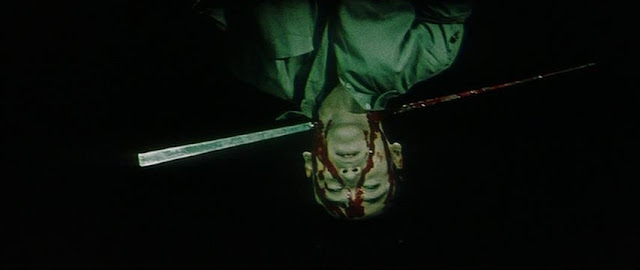(1960) Directed by Nobuo Nakagawa; Written by Nobuo Nakagawa and Ichirô Miyagawa; Starring: Shigeru Amachi, Utako Mitsuya, Yôichi Numata, Hiroshi Hayashi, Jun Ôtomo, Akiko Yamashita, Kiyoko Tsuji, Fumiko Miyata and Akira Nakamura; Available on DVD
Rating: ****
“The Greek philosopher Carneades posed this question: There’s a plank, and two people are drowning. If one of them hangs on to the plank, the other will die. In such a situation, if the one with the plank gets rid of the one without, is that person guilty? That’s more or less the idea of ‘an act of necessity.’ Mr. Nakagawa (the film’s director) said it may not be guilt in a legal sense, but it is guilt.” – Ichirô Miyagawa (screenwriter)
Cinema transports us to places we’ve never been, and sometimes where we’d never want to be. With Jigoku (the Japanese word for “hell.”), director/co-writer Nobuo Nakagawa takes us on a journey where few other films dare to tread. Nakagawa doesn’t merely suggest hell, or give us a brief glimpse of the horrors awaiting; a substantial portion of the film is devoted to taking the viewer into a Buddhist version of hell and its numerous torments.* While the major studios, such as Toho, probably wouldn’t touch this subject matter with a three-meter pole, Shintoho and producer Mitsugu Ôkura proved to be up to the task. Sort of the equivalent of the “Poverty Row” film companies of the ‘30s and ‘40s in the U.S., Shintoho was known for churning out films with more lurid content (often dealing with sex, crime, horror and pulpy science fiction). Sadly, Jigoku (aka: The Sinners of Hell) proved to be the short-lived studio’s swan song, but what a way to make an impact.
* Fun Fact #1: Referring to producer Mitsugu Ôkura, screenwriter Ichirô Miyagawa commented: “…Mr. Ôkura called in Mr. Nakagawa, asking if he had any good projects in mind. Nakagawa said he’d like to shoot a film about bad people who should go to hell. Mr. Okura said, ‘All right. Make a film called Heaven and Hell.’ When we completed the script, Okura scolded us, saying heaven was nowhere to be seen. I dodged the issue by saying I would write about heaven in the sequel.” For the record, the sequel was never made.
** Fun Fact #2: The film’s powerful imagery, depicting some
of the many punishments awaiting sinners within the eight greater hells was based, in part, on the 12th Century
painting, Jigoku-zôshi (the “Hell Scroll”) and the 10th Century text, Ōjōyōshū by Buddhist monk Genshin.
Shirô Shimizu (Shigeru Amachi) is a young graduate student, engaged to the daughter of one of his professors (Akira Nakamura). In the opening scene, he attends a lecture by said professor, discussing the Buddhist concept of hell, setting the stage for the rest of the film. One night, after riding home from his fiancée Yukiko’s (Utako Mitsuya) house he asks his friend Tamura (Yôichi Numata) to take a detour. Tamura hits a drunken yakuza (Hiroshi Izumida) who wandered into the road, but instead of stopping to help, drives away. The yakuza’s grief-stricken mother and girlfriend (Kiyoko Tsuji and Akiko Ono) vow revenge. Soon afterward, another tragedy befalls Shirô after he insists that his fiancée take a ride home in a taxi, only to witness her death in a traffic accident. But Shirô’s troubles are only beginning when he’s plagued by a cascade of calamities upon his return to his home town – all while being hounded by the enigmatic Tamura.
Jigoku was groundbreaking in its explicit depiction of Buddhist hell’s myriad torments, based on karmic retribution. The damned are doomed to a perpetual hell of their own making, where punishment is doled out, based on their respective crimes in life. The final third of the film is devoted to a cornucopia of agonies in a nightmare landscape: people wade through a lake of filth, eyes are gouged out, bodies are flayed, and the damned are buried up to their necks (or inverted with only their feet sticking out).* It’s a disconcerting experience, bathed in red and green light, and redolent of symbolism throughout.
* Fun Fact #3: According to actor Yôichi Numata, the studio
was so cash-strapped that the cast had to dig their own holes.
Jigoku was a box office disappointment, partially on account of mixed reviews and never receiving the distribution it deserved (the film company Shintoho ran out of money by that point), but it’s hard to imagine this surreal excursion into the underworld connecting with mainstream audiences. Although it likely baffled or disgusted those who managed to see it, the movie eventually became a cult classic in its native Japan, and has become a fertile ground for other filmmakers, following in Nakagawa’s footsteps (witness José Mojica Marins’ 1967 movie, This Night I’ll Possess Your Corpse, with its color hell-sequence). Its core message is simple: even if you can escape prosecution by the authorities or the scrutiny of your peers, you can’t flee your tormented conscience. Your mind becomes your own portable version of hell. Jigoku isn’t the easiest film to watch, nor the most narratively cohesive, but what it lacks in coherence, it makes up with an abundance of unforgettable imagery which will remain tattooed on your visual cortex.
Sources for this article: “Building the Inferno,” 2006
making-of documentary for the Criterion DVD, Asian Horror, by Andy
Richards; Japanese Visual Cultures:The Buddhist Hells;
eMuseum – Tokyo National Museum







Wow! This one sounds unnerving and fascinating! The journey into hell sounds like an unforgettable nightmare! And thanks again for the fun facts, Barry! I love that the actors had to dig their own holes!
ReplyDeleteThanks, John! It's not without its faults, but the images are undeniably creepy. This movie was truly ahead of its time.
Delete